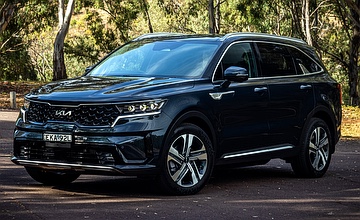2022 Kia Sorento GT-Line PHEV Review

KIA is moving rapidly towards new energy vehicles, which is why the number of electrified models in its portfolio has increased considerably. From family SUVs, such as the Sorento GT-Line PHEV tested here, to the forthcoming and exciting EV6, the Korean brand will soon offer something for everyone; Kia has promised to democratise its EV range – and that goal is almost within reach.
Well, it’s close, but not quite there just yet… For the time being, Kia’s plug-in hybrid and battery-electric variants attract a distinct premium over their combustion-engined counterparts. Case in point, the Sorento GT-Line PHEV, which at $81,900 drive-away is $14,700 dearer than its turbo-diesel-powered – and otherwise identically specified – sibling.
And while the high-pricing trend for plug-in hybrid electric vehicles (PHEVs) and battery-electric vehicles (BEVs) isn’t exclusive to Kia – every manufacturer demands a premium for its comparable new energy variants – it is one that raises the value question for potential customers. Besides the feel-good factor that comes from “saving the planet”, there are few other incentives to make the move to an electrified model, even when it is one that is as good as the Sorento GT-Line PHEV.
The additional expense of the Sorento GT-Line PHEV comes entirely from its driveline. The offering combines a (132kW/265Nm) 1.6-litre turbocharged four-cylinder petrol engine with a 67kW/304Nm electric motor to provide a peak system outputs 195kW and 350Nm. The combo is paired with a six-speed epicyclic automatic transmission and all-wheel drive.
Electric power is drawn from a 14kWh lithium-ion polymer battery pack, which can offer up to 68km (NEDC) or 57km (WLTP) of all-electric driving range, and which contributes to an ADR combined-cycle fuel consumption figure of just 1.6 litres per 100km (and 36g/km of CO2 emissions). Kia says the Sorento GT-Line PHEV's battery pack can be charged at a rate of up to 3.3kW, which will take it from 15 to 95 per cent capacity in three hours and 25 minutes.
The South Korean brand’s large SUV model was designed from the outset to house a battery pack and of its associated mechanical items beneath the floor, which means there is little negative impact on cabin or cargo space when compared to petrol- or diesel-powered variants.
The seven-seater offers 604 litres of cargo space in five-seat mode compared with the diesel model’s 616 litres, and towing capacity drops to 1350kg (braked) against the ICE-only variant’s 2000kg.
Like the “regular” Sorento GT-Line, the PHEV variant scores all the luxuries and tech features one expects at its price point.
Quilted Nappa leather upholstery, heated and ventilated front seats, a 10.25-inch infotainment array, Apple CarPlay and Android Auto connectivity, 12-speaker Bose audio system, LED ambient cabin lighting, a configurable 12.3-inch digital instrument panel, Terrain Select multi-mode all-wheel drive system, panoramic sunroof, LED head- and tail-lights, and model-specific 19-inch alloy wheels with full-size spare.
Currently, the only direct rival to the Kia Sorento GT-Line PHEV is the Toyota Kluger Grande eFour (which is a series hybrid and not a plug-in) with a recommended retail price of $75,700 (plus on-road costs). Unlike the Toyota, Kia’s plug-in hybrid Sorento is not available in lower trim grades.
All Kia passenger models are covered by a seven-year/unlimited warranty, which includes roadside assistance and capped-price servicing. Service intervals are set at 12 months or 15,000km (whichever comes first) and servicing costs over five years amount to $2388.